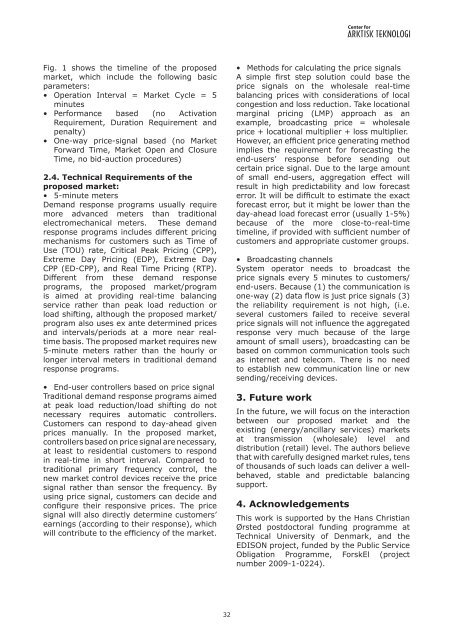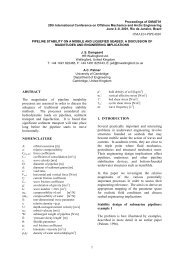Energiforsyning i Arktis – hvilken vej vælger Grønland? - Artek ...
Energiforsyning i Arktis – hvilken vej vælger Grønland? - Artek ...
Energiforsyning i Arktis – hvilken vej vælger Grønland? - Artek ...
Create successful ePaper yourself
Turn your PDF publications into a flip-book with our unique Google optimized e-Paper software.
Fig 1 shows the timeline of the proposed<br />
market, which include the following basic<br />
parameters:<br />
• Operation Interval = Market Cycle = 5<br />
minutes<br />
• Performance based (no Activation<br />
Requirement, Duration Requirement and<br />
penalty)<br />
• One-way price-signal based (no Market<br />
Forward Time, Market Open and Closure<br />
Time, no bid-auction procedures)<br />
2.4. Technical Requirements of the<br />
proposed market:<br />
• 5-minute meters<br />
Demand response programs usually require<br />
more advanced meters than traditional<br />
electromechanical meters These demand<br />
response programs includes different pricing<br />
mechanisms for customers such as Time of<br />
Use (TOU) rate, Critical Peak Pricing (CPP),<br />
Extreme Day Pricing (EDP), Extreme Day<br />
CPP (ED-CPP), and Real Time Pricing (RTP)<br />
Different from these demand response<br />
programs, the proposed market/program<br />
is aimed at providing real-time balancing<br />
service rather than peak load reduction or<br />
load shifting, although the proposed market/<br />
program also uses ex ante determined prices<br />
and intervals/periods at a more near realtime<br />
basis The proposed market requires new<br />
5-minute meters rather than the hourly or<br />
longer interval meters in traditional demand<br />
response programs<br />
• End-user controllers based on price signal<br />
Traditional demand response programs aimed<br />
at peak load reduction/load shifting do not<br />
necessary requires automatic controllers<br />
Customers can respond to day-ahead given<br />
prices manually In the proposed market,<br />
controllers based on price signal are necessary,<br />
at least to residential customers to respond<br />
in real-time in short interval Compared to<br />
traditional primary frequency control, the<br />
new market control devices receive the price<br />
signal rather than sensor the frequency By<br />
using price signal, customers can decide and<br />
configure their responsive prices The price<br />
signal will also directly determine customers’<br />
earnings (according to their response), which<br />
will contribute to the efficiency of the market<br />
32<br />
• Methods for calculating the price signals<br />
A simple first step solution could base the<br />
price signals on the wholesale real-time<br />
balancing prices with considerations of local<br />
congestion and loss reduction Take locational<br />
marginal pricing (LMP) approach as an<br />
example, broadcasting price = wholesale<br />
price + locational multiplier + loss multiplier<br />
However, an efficient price generating method<br />
implies the requirement for forecasting the<br />
end-users’ response before sending out<br />
certain price signal Due to the large amount<br />
of small end-users, aggregation effect will<br />
result in high predictability and low forecast<br />
error It will be difficult to estimate the exact<br />
forecast error, but it might be lower than the<br />
day-ahead load forecast error (usually 1-5%)<br />
because of the more close-to-real-time<br />
timeline, if provided with sufficient number of<br />
customers and appropriate customer groups<br />
• Broadcasting channels<br />
System operator needs to broadcast the<br />
price signals every 5 minutes to customers/<br />
end-users Because (1) the communication is<br />
one-way (2) data flow is just price signals (3)<br />
the reliability requirement is not high, (i e<br />
several customers failed to receive several<br />
price signals will not influence the aggregated<br />
response very much because of the large<br />
amount of small users), broadcasting can be<br />
based on common communication tools such<br />
as internet and telecom There is no need<br />
to establish new communication line or new<br />
sending/receiving devices<br />
3. Future work<br />
In the future, we will focus on the interaction<br />
between our proposed market and the<br />
existing (energy/ancillary services) markets<br />
at transmission (wholesale) level and<br />
distribution (retail) level The authors believe<br />
that with carefully designed market rules, tens<br />
of thousands of such loads can deliver a wellbehaved,<br />
stable and predictable balancing<br />
support<br />
4. Acknowledgements<br />
This work is supported by the Hans Christian<br />
Ørsted postdoctoral funding programme at<br />
Technical University of Denmark, and the<br />
EDISON project, funded by the Public Service<br />
Obligation Programme, ForskEl (project<br />
number 2009-1-0224)





